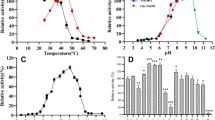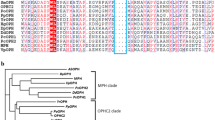Abstract
β-Ketoadipate enol-lactone hydrolase (EC 3.1.1.24) and succinyl CoA:β-ketoadipate transferase (EC 2.8.3.6) catalyze consecutive metabolic reactions in bacteria. The enzymes appear to be members of different families of related proteins. Enzymes within the enol-lactone hydrolase family appear to have diverged so extensively that common ancestry sometimes is not directly evident from comparison of NH2-terminal amino acid sequences of the proteins. Amino acid sequences at or near the active sites of the enzymes are likely to have been conserved, and hence a chemical proble that reacted specifically near the active sites of the enzymes might identify regions of amino acid sequence in which evolutionary affinities among widely divergent proteins could be identified. p-Chloromercuribenzoate appears to be such a probe because enol-lactone hydrolases and CoA transferases from Acinetobacter calcoaceticus and Pseudomonas putida were completely inhibited by stoichiometric quantities of the compound which appears to modify selectively cysteinyl side chains at or near the active sites of the enzymes. Stoichiometric inhibition of P. putida enol-lactone hydrolase was observed in the presence of excess dithiothreitol; therefore the reactive cysteinyl residue in this enzyme appears to be nucleophilic. The hydrolase is inhibited by β-ketoadipate, but the compound must be supplied at 10 mM concentrations in order to achieve 50% inhibition, so the product inhibition is unlikely to be significant under physiological conditions.
Similar content being viewed by others
References
Canovas JL, Stanier RY (1967) Regulation of the enzymes of the β-ketoadipate pathway in Moraxella calcoacetica. Eur J Biochem 1:289–300
Dagley S (1975) A biochemical approach to some problems of environmental pollution. In: Campbell PN, Aldridge WN (eds) Essays in biochemistry, vol 11. Academic Press, New York, A-transferase: Kinetics, catalytic pathway and structure. Arch
Donoghue NA, Norris DB, Trudgill PW (1976) The purification and properties of cyclohexanone oxygenase from Nocardia globerula CL1 and Acinetobacter NCIB 9871. Eur J Biochem 63:175–192
Horowitz NH (1945) On the evolution of biochemical syntheses. Proc Natl Acad Sci 31:153–157
Johnson BF, Greenberg J (1973) Modification of three enzymes of the β-ketoadipate pathway by N-methyl-N′-nitrosoguanidine. Chem-Biol Interactions 7:17–28
Kersten PJ, Dagley S, Whittaker JW, Arciero DM, Lipscomb JD (1982) 2-Pyrone-4,6-dicarboxylic acid, a catabolite of gallic acids in Pseudomonas species. J Bacteriol 152:1154–1162
McCorkle GM, Yeh W-K, Fletcher P, Ornston LN (1980) Repetitions in the NH2-terminal amino acid sequence of β-ketoadipate enol-lactone hydrolase from Pseudomonas putida. J Biol Chem 255:6335–6341
Moore SA, Jencks WP (1982a) Reactions of acyl phosphates with carboxylate and thiol anions. J Biol Chem 257:10874–10881
Moore SA, Jencks WP (1982b) Formation of active site thiol esters of CoA transferase and the dependence of catalysis of specific binding interactions. J Biol Chem 257:10893–10907
Ornston LN (1966) The conversion of catechol and protocatechuate to β-ketoadipate by Pseudomonas putida. I. Biochemistry. J Biol Chem 241:3787–3794
Schmidt E, Knackmuss HJ (1980) Chemical structure and biodegradability of halogenated aromatic compounds. Biochem J 192:339–347
Sharp JA, Edwards MR (1978) Purification and properties of succinyl-coenzyme A-3-oxo acid coenzyme A transferase from sheep kidney. Biochem J 173:759–765
Snell EE, Haskell BE (1971) The metabolism of vitamin B6. In: Florkin M, Stotz EH (eds) Comprehensive biochemistry, vol 21. Elsevier Publishing Company, New York, pp 47–71
Sramek SJ, Frerman FE (1975a) Purification and properties of Escherichia coli coenzyme A-transferase. Arch Biochem Biophys 171:14–26
Sramek SJ, Frerman FE (1975b) Escherichia coli coenzyme A-transferase: Kinetics, catalytic pathway and structure. Arch Biochem Biophys 171:27–35
Stanier RY (1980) The journey, not the arrival, matters. In: Starr MP (ed) Annual review of microbiology, vol 34. Annual Reviews Inc., Palo Alto, California, pp 1–48
Stanier RY, Ornston LN (1973) The β-ketoadipate pathway. In: Rose AH, Tempest DW (eds) Advances in microbial physiology, vol 9. Academic Press, London, pp 89–151
White H, Solomon F, Jencks WP (1976) Utilization of the inactivation rate of coenzyme A transferase by thiol reagents to determine properties of the enzyme-CoA intermediate. J Biol Chem 251:1700–1707
Yeh W-K, Fletcher P, Ornston LN (1980) Evolutionary divergence of coselected β-ketoadipate enol-lactone hydrolases in Acinetobacter calcoaceticus. J Biol Chem 255:6342–6346
Yeh W-K, Ornston LN (1980) Origins of metabolic diversity: Substitution of homologous sequences into genes for enzymes with different catalytic activities. Proc Natl Acad Sci USA 77:5365–5369
Yeh W-K, Ornston LN (1981) Evolutionarily homologous α2β2 oligomeric structures in β-ketoadipate succinyl CoA transferase from Acinetobacter calcoaceticus and Pseudomonas putida. J Biol Chem 256:1565–1569
Yeh W-K, Shih C, Ornston LN (1982) Overlapping evolutionary affinities revealed by comparison of amino acid compositions. Proc Natl Acad Sci USA 79:3794–3797
Author information
Authors and Affiliations
Additional information
Dedicated to Roger Stanier with whom biochemistry was ‘without tears’ (Stanier 1980)
Rights and permissions
About this article
Cite this article
Yeh, WK., Ornston, L.N. p-Chloromercuribenzoate specifically modifies thiols associated with the active sites of β-Ketoadipate enol-lactone hydrolase and succinyl CoA: β-Ketoadipate CoA transferase. Arch. Microbiol. 138, 102–105 (1984). https://doi.org/10.1007/BF00413008
Received:
Accepted:
Issue Date:
DOI: https://doi.org/10.1007/BF00413008




